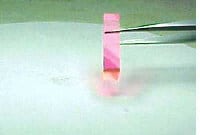Quantum entanglement is a phenomenon usually associated with the microscopic world. Now, however, physicists from the Universities of Chicago and Wisconsin in the US and University College London have seen its effects in the bulk properties of a magnetic material for the first time. The researchers believe that their work has implications both for understanding quantum magnetism and in building quantum computers – where entanglement is the key to the increased power of such devices (S Ghosh et al. 2003 2003 Nature 425 48).

Entanglement is a feature of quantum mechanics that allows particles with two distinct quantum states to share a much closer relationship than classical physics allows. If two particles are entangled, then we can know the state of one particle by measuring the state of the other. For example, if one particle has a spin ‘up’ then the other automatically has a spin ‘down’. Entanglement is crucial for quantum computing and teleportation but its effects are not generally seen beyond the scale of subatomic particles.
Thomas Rosenbaum at the University of Chicago and colleagues performed their experiment on a single crystal of a simple magnetic salt that contains lithium, holmium, yttrium and fluorine (figure 1). The holmium atoms in this salt all behave like tiny magnets and, in the absence of a magnetic field, their magnetic moments point in random directions. When a field is applied, however, the moments align up with the direction of the field (figure 2).
The researchers measured the ease with which the magnetic moments aligned with the field at different temperatures. They then compared this ‘susceptibility’ to the material’s ability to absorb heat and found that the two properties were very different.
The susceptibility increases smoothly as the sample cooled while the heat absorption varies in a more irregular way. This is in contrast to ordinary materials and, according to the researchers, can only be explained if there is quantum mechanical mixing – or entanglement – of the different magnetic states in the system. This is because entanglement effects contribute much more strongly to the susceptibility than to the heat absorption.
To confirm their findings the researchers combined their experimental results with computer simulations and theory. The salt’s susceptibility was found to match theoretical values that had been predicted to take quantum entanglement into account.
The researchers say that their work shows that entanglement can occur in a disordered solid that is far from perfect. “We see these dense, solid state magnets as promising systems for both fundamental quantum mechanics and potential quantum computing applications,” Rosenbaum told PhysicsWeb. “The challenge remains to manipulate the entanglement to perform actual quantum logic operations.”




